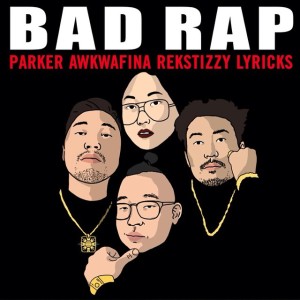 Modern day hip hop is a fascinating beast. Unless you have the right combination of lyrics and beats it’s hard to make it big, or at least past the small club level, and even then it’s very difficult. It’s even harder if you’re not an Afrithn American due to the overall aesthetic and origins of the popular genre. Salima Koromo’s new documentary Bad Rap focuses on four Asian American rappers as they struggle to not only break through the clutter as artists, but doing so by breaking the racial barrier and proving that looks can be deceiving.
Modern day hip hop is a fascinating beast. Unless you have the right combination of lyrics and beats it’s hard to make it big, or at least past the small club level, and even then it’s very difficult. It’s even harder if you’re not an Afrithn American due to the overall aesthetic and origins of the popular genre. Salima Koromo’s new documentary Bad Rap focuses on four Asian American rappers as they struggle to not only break through the clutter as artists, but doing so by breaking the racial barrier and proving that looks can be deceiving.
Utilizing a combination of interviews and performances, Bad Rap follows the well-known but under performing artist Dumbfounded, the quirky hipster female rapper Awkwafina, the daring visual maestro Rekstizzy and the spiritually torn rapper Lyricks.
As we are walked through each of their stories, Dumbfounded seems to be the most interesting but also the most frustrating. He is the largest name in the film because of his notoriety but not necessarily the most successful. His transition from a top name in the battle rap scene to someone trying to put out a mainstream album hasn’t been smooth. Some might say his work is a little uninspired and which could be a direct result of his lack of focus. On the other hand, Awkwafina is the most successful thanks to her unique look and hilarious lyrics. While they’re all friends helping each other out in whatever ways they can, Rekstizzy and Lyricks are struggling the most, both of whom are struggling with identity issues. One is an external struggle to be unique visually and not care what others think while the other is struggling internally, his devout protestant ways constantly battling the hip hop lifestyle that he loves.
On the whole, there were three fascinating revelations that were unveiled during the documentary. One, lyrics aren’t everything, you need to be an entire package if you want any shot of real success, that means good beats, lyrics, and style, you need to be something unique. Secondly, if you’re Asian and female, you have a much better chance of being discovered and edging closer to the line of mainstream success. While confirmed by the men in the documentary, this was also confirmed by Awkwafina herself which poses an interesting theory that maybe you need to be a combination of two minority-like features to stand out in the hip hop industry. Thirdly, the only real way Asian American rappers will have a legitimate shot of exploding onto the scene is if someone becomes a mega-star the same way Eminem paved the way for other white rappers in the modern era (I’m sure The Beastie Boys helped in a way too). Unfortunately, the Chinese rapper Jin didn’t pan out the way he should have (which is unfortunate because I remember buying one of his songs on Napster back in 2004-and I still listen to it).
As we watch the documentary unfold, one of the lessons learned is that Asian American rappers try not, and shouldn’t, focus on their race. While for some it may be a selling point, they feel, and righty fully so, that it distracts people from their actual talent. It’s like when people will sell a movie as directed by a female rather than just pitching the movie because the quality is great. On the flip side, that’s what makes them unique in a way and it may become a selling point from a record label perspective. It shouldn’t because it might make people skeptical but that’s the harsh reality that Asian artists in the hip hop realm experience regularly.
Overall, Bad Rap was an “OK” documentary. There’s very little to actually get excited about as the stories are being told. While Awkawfina is the only one to actually (temporarily) make something of herself, there’s no build-up to it. The most exciting part comes more than half way into the film when we get to witness Dumbfounded return to the battle scene after five years. But even while he crushes the first round, the doc makes us believe that he didn’t win his battle and, as a result, no opportunities seem to come from his exposure during the publicized event hosted by Drake. The film isn’t compelling enough to make us root for anyone outright, but it poses a good question and it’s intriguing enough that hopefully people will start to think more about exploring independent outlier artists in hip hop and finding ways to cultivate them for heightened success because, in all honesty, the talent exists, just overcome the challenge of marketing it.

















Recent Comments